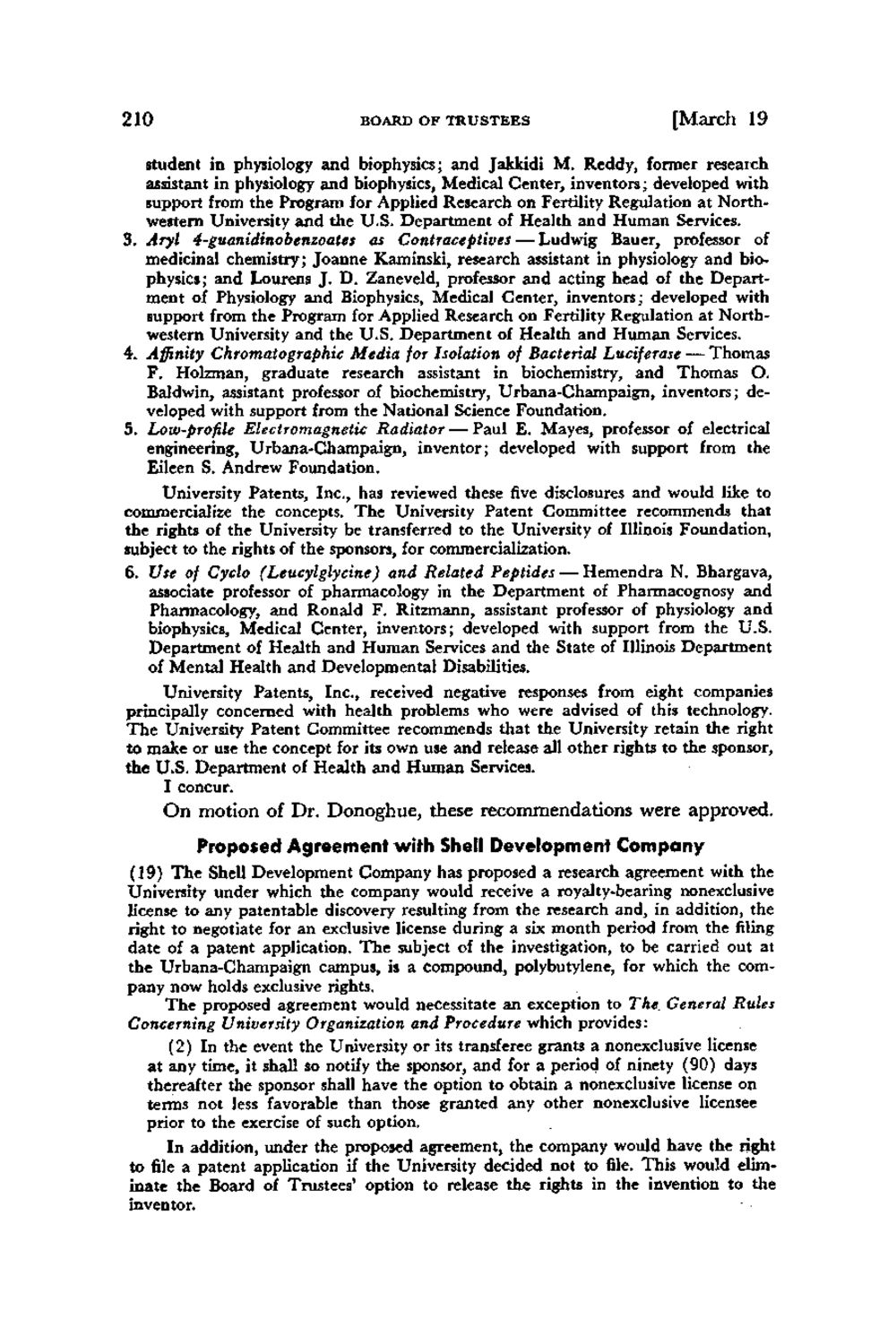| |
| |
Caption: Board of Trustees Minutes - 1982
This is a reduced-resolution page image for fast online browsing.

EXTRACTED TEXT FROM PAGE:
210 BOARD OF TRUSTEES [March 19 student in physiology and biophysics; and Jakkidi M. Reddy, former research assistant in physiology and biophysics, Medical Center, inventors; developed with support from the Program for Applied Research on Fertility Regulation at Northwestern University and the U.S. Department of Health and Human Services. 3. Aryl 4-guanidinobenzoates as Contraceptives — Ludwig Bauer, professor of medicinal chemistry; Joanne Kaminski, research assistant in physiology and biophysics; and Lourens J. D. Zaneveld, professor and acting head of the Department of Physiology and Biophysics, Medical Center, inventors; developed with support from the Program for Applied Research on Fertility Regulation at Northwestern University and the U.S. Department of Health and Human Services. 4. Affinity Chromatographic Media for Isolation of Bacterial Luciferase — Thomas F. Holzman, graduate research assistant in biochemistry, and Thomas O. Baldwin, assistant professor of biochemistry, Urbana-Champaign, inventors; developed with support from the National Science Foundation. 5. Low-profile Electromagnetic Radiator — Paul E. Mayes, professor of electrical engineering, Urbana-Champaign, inventor; developed with support from the Eileen S. Andrew Foundation. University Patents, Inc., has reviewed these five disclosures and would like to commercialize the concepts. The University Patent Committee recommends that the rights of the University be transferred to the University of Illinois Foundation, subject to the rights of the sponsors, for commercialization. 6. Use of Cyclo (Leucylglycine) and Related Peptides — Hemendra N. Bhargava, associate professor of pharmacology in the Department of Pharmacognosy and Pharmacology, and Ronald F. Ritzmann, assistant professor of physiology and biophysics, Medical Center, inventors; developed with support from the U.S. Department of Health and Human Services and the State of Illinois Department of Mental Health and Developmental Disabilities. University Patents, Inc., received negative responses from eight companies principally concerned with health problems who were advised of this technology. T h e University Patent Committee recommends that the University retain the right to make or use the concept for its own use and release all other rights to the sponsor, the U.S. Department of Health and H u m a n Services. I concur. On motion of Dr. Donoghue, these recommendations were approved. Proposed Agreement with Shell Development Company (19) T h e Shell Development Company has proposed a research agreement with the University under which the company would receive a royalty-bearing nonexclusive license to any patentable discovery resulting from the research and, in addition, the right to negotiate for an exclusive license during a six month period from the filing date of a patent application. T h e subject of the investigation, to be carried out at the Urbana-Champaign campus, is a compound, polybutylene, for which the company now holds exclusive rights. The proposed agreement would necessitate an exception to The. General Rules Concerning University Organization and Procedure which provides: (2) In the event the University or its transferee grants a nonexclusive license at any time, it shall so notify the sponsor, and for a period of ninety (90) days thereafter the sponsor shall have the option to obtain a nonexclusive license on terms not less favorable than those granted any other nonexclusive licensee prior to the exercise of such option. In addition, under the proposed agreement, the company would have the right to file a patent application if the University decided not to file. This would eliminate the Board of Trustees' option to release the rights in the invention to the inventor.
| |